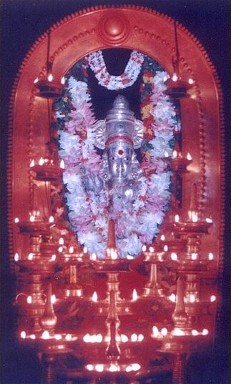Manapullikavu മണപ്പുള്ളിക്കാവ് | |
|---|---|
Temple/Neighborhood | |
 | |
| Coordinates: 10°45′29″N76°39′54″E / 10.75806°N 76.66500°E | |
| Country | |
| State | Kerala |
| District | Palakkad |
| Languages | |
| • Official | Malayalam, English |
| Time zone | UTC+5:30 (IST) |
| PIN | 678013 |
| Telephone code | 0491 |
| Vehicle registration | KL - 09 |
| Climate | tropical (Köppen) |
Manapullikavu is a Hindu temple located in Palakkad city, Kerala of India. The temple is most famous for the annual festival that takes place in the temple known as Manappullikavu Vela. Manapullikavu is also a major residential area in Palakkad city comprising apartments and residential colonies. Manappulikavu is ward 27 of Palakkad Municipality. [1]
Contents
Sree Manappully Bhagavathy Temple is situated in Palakkad city, Kerala . It is on the Palakkad–Chittur road and hardly 200 meters away from the National Highway 544 .Earlier the temple was under the private ownership of ‘Kenath Family’. Now the temple is under Malabar Devaswom Board (MDB). Kariyannur Manakkal Bavathrathan Namboothiripad of Pattambi is the Thanthri (Head Priest) of the temple now.
Sri Manappully Bhagavathy Temple has a very ancient history. It is believed that the temple originally belonged to Sri Mattappilly Bhadrakali Mana, a famous Kerala Brahmin family of Kerala. Numerous Bhrahmin families living on the banks of Holi River Sokanasini (Bharathapuzha) used to perform ‘Yagas’ on the river bed. Thus the area came to be known as ‘Yaga-kara’ which later came to be known as ‘Yakkara’. The eastern part of Yakkara where the temple is located, is called East Yakkara and the other side as ‘West Yakkara’. It is believed that the ‘Moolasthanam’ of Bhagavathy was at West Yakkara and it was subsequently shifted to the present Sanctum Santorum of the East Yakkara temple. (It is believed that a saintly Brahmin of Yagakkara conducted his prayers in his kitchen which is also called as ‘madappalli’. It is considered that in the course of time and usage, the area came to be known as "Manappulli").
Sree Manappulli Bhagavathi is Bhadrakaali and was born out of the sacred "Jada" of Lord Shiva during Dakshayaga. She is black in colour, with four hands, each one having Soolam, Kapalam, Gadkam and Khedam. She is with three eyes, two ‘Dhamshtram’, with ‘Pattudayada’ and valuable ornaments. The Prathishta is in ‘Shanta Bhava’. During ‘Chandattam’ ceremony She turns to ‘Rudra Bhava’ and becomes ‘Shanta Swaroopini ‘after accepting the ‘Kadummadura Payasa Nivedyam’. She is believed to satisfy the desires, hopes and aspirations of her true devotees and also protect them from all evils.
According to a legendary myth about the temple, an Asura called Neelan was disturbing the people with his misdeeds and became a menace to them. The people, complained about this to Parasuraman and he in turn sought a remedy from Lord Paramasiva. Paramasiva incarnating his female personality to Bhadra Kali and sent her to Akamalavaram to kill Neelan. After killing Neelan, Kali became Manappulli Bhagavathy showering prosperity to her devotees.
The Palghat district where the temple is situated, has mainly paddy cultivation as the main occupation of the people. The district is called the ‘Rice Bowl’ of Kerala. The social and cultural customs of the people are, therefore, one way or other, connected with paddy cultivation. They believe that the Goddesses of ‘Kavu’ (temple) protect them in their ‘Thattakam’ (meaning the area where they live, surrounds the ‘Kavu’). The people make offerings to the Goddesses in their ‘Thattakam’ in the form agricultural produces having bearing on the seasonal agriculture. The people prayed for good harvest and as an offering for this, they celebrates ‘Kathir’ in the third Friday of the Malayalam month of ‘Vrichikam’. On this day, a procession carrying ‘Sarodam’, in a very ornately decorated form is taken out in the evening from the premises of Lord Muniyappan temple, situated at the southern side of the Bhagavathy temple and it culminates at the Manappully Bhagavathy temple at dusk, passing through the streets of Manappullikavu Nair Thara. Another procession from Kenathuparambu, also joins the procession at the Manappullikavu junction and culminates at the temple. An attractive part of this ‘Kathir’ is the procession carrying decorative umbrellas made of palm leaves tied to freshly cut bamboo poles accompanied by ‘drum beating’. The Kathir literally announces the ensuing ‘Vela’ festival. The procession also carries ‘Kathir Koodu’, small balls made of tender palm leaves containing freshly plucked ‘Nel kathir’ (paddy bunches) which are distributed to all the houses in the area and hung in the front yard of each house till the next ‘Kathir’. These practices continue to be observed even now with great pomp and show. After the ‘Kathir’, the next preparatory function of the Vela is ‘Kanyar’ (Kodiyettam), which is performed on the first Friday of the Malayalam Month ‘Kumbam’. The huge freshly cut bamboo pole (flag post) with a typical flag - Koora is hoisted in front of the temple with rituals. This declares and denotes the ensuing Manappully Bhagavathy Vela.
